Visit Rwanda
Volcanoes National Park
Volcanoes National Park (French: Parc National des Volcanos Kinyarwanda: Pariki y’Igihugu y’Ibirunga) lies in northwestern Rwanda and borders Virunga National Park in the Democratic Republic of Congo and in north, Mgahinga National Park in Uganda. The national park is known as a haven for the rare and endangered mountain gorilla and golden monkeys, which has attracted a number of visitors to this great park.
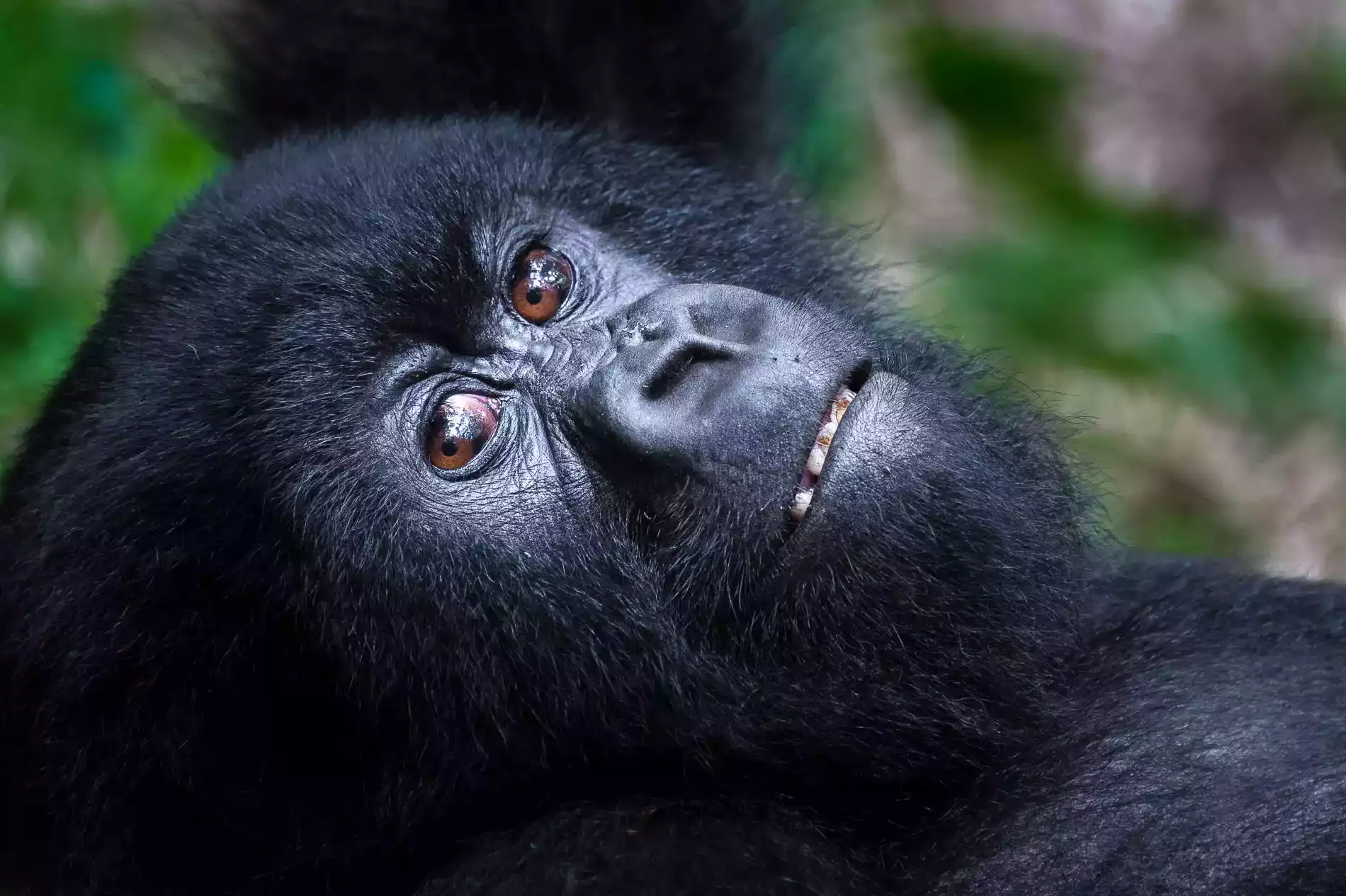
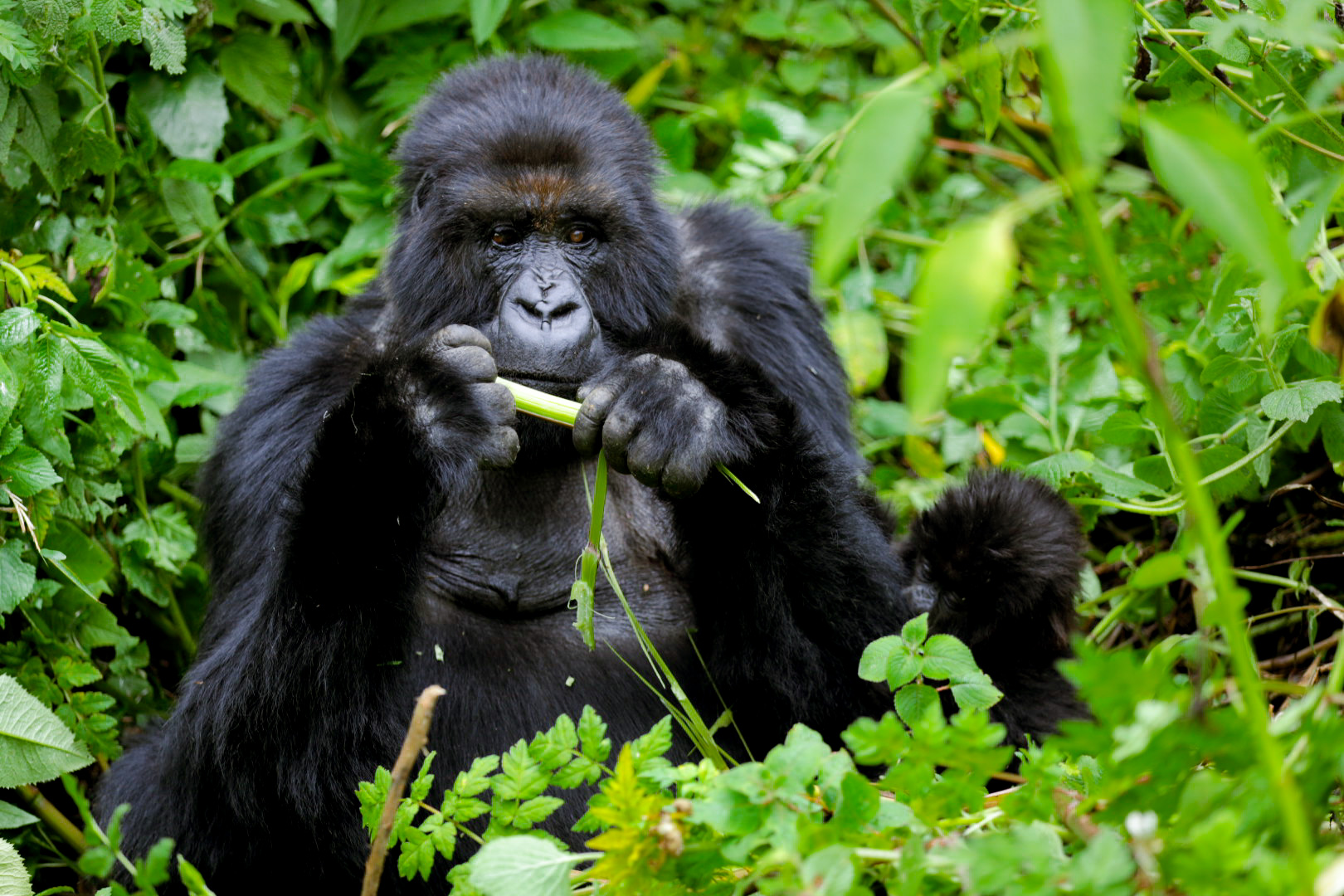
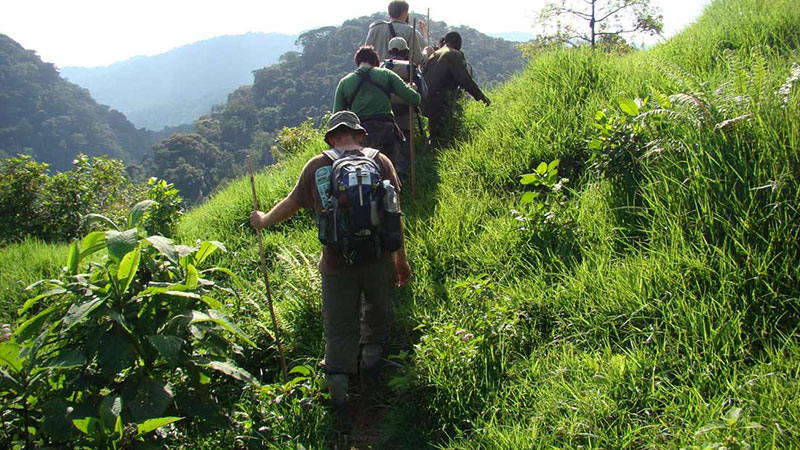
Location, size, & facts about Volcanoes NP
Volcanoes National Park is found in Ruhengeri region, Northwestern Rwanda and from Kigali, it is accessible 2 to 3 hours’ drive. Bordering this spectacular Rwanda safari park is Congo’s designated world heritage site –Virunga National Park and Uganda’s Mgahinga Gorilla National Park.
Volcanoes National Park has its borders spread up to 160 sq.km, forming part of the vast Virunga Conservation Area that spans 433 sq.km. The park lies at an altitude of 2400 to 4507 meters. Volcanoes National Park is a preferred Rwanda tour protected area for its exhilarating mountain gorilla trekking experiences.
This park is located within the Virunga Mountain ranges, the chain Volcano Mountains that spread across 3 African states: Rwanda, Uganda and Congo. Volcanoes National Park is found in Northwest of Rwanda, a remarkable location where Dian Fossey conducted her research on the endangered mountain gorillas till 1985 when she was murdered by unknown people.
Gorilla trekking
Gorilla trekking is the leading experience that most tourists come to enjoy in Volcanoes National Park. The park contains 12 habituated gorilla families; each family is visited by maximum of 8 visitors. The day trek to see mountain gorillas begins with briefing at Kinigi Area where you get insight into guidelines for gorilla trekking. The park official assigns gorilla groups to every group comprising of 8 tourists.
The long day trek can take between 2 and 6 hours which includes one hour of observing how the endangered mountain gorillas behave. The 12 gorilla groups translate to 96 gorilla permits, each permit is sold at USD 1500 per person. The gorilla families to visit include Agashya gorilla groups, Amahoro, Karisimbi, Susa A, Umubano, Hirwa, Ugenda, Titus, Kwitonda and Pablo.
Golden monkey tracking
Golden monkey tracking offer a lifetime opportunity to Rwanda safari travelers to immerse themselves into the wild to explore more about golden monkeys. The golden monkey trek can last for 2-4 hours and includes one hour of up close and personal with golden monkeys in the wild. Tracking golden monkeys in Rwanda’s Volcanoes NP costs USD 100 for a single permit per day.
Hiking
Besides trekking to see golden monkeys and mountain gorillas, Volcanoes NP also provides the most thrilling volcano hiking experiences. The park lies within the Virunga Region, and 5 of the 8 Virunga Massifs all exist in this park. The volcano hikes are conducted on Mount Bisoke which requires about 6 hours ascend and this includes 2 hours descending to the briefing point. Mount Karisimbi –the tallest of the 8 Virunga Volcanoes is hiked in the Volcanoes NP Rwanda and takes about 2 days to get to 4507 meters elevation.
Akagera National Park
Akagera National Park is Rwanda’s only savanna wildlife park, home to all the big 5 game. This park is located in Eastern Rwanda, established in 1934 and has land area coverage of 1122sq.km. Akagera NP derives its from Kagera River, a river which flows through its Eastern border with Tanzania. Kagera River empties its water into Lake Ihema and many other small lakes in the park and its surrounding.
Akagera National Park is an extensive savanna park with breathtaking landscape. The park’s landscape features bush and acacia vegetation cover. Akagera NP is considerably the largest wetland protected area in East-Central Africa. Swamps and many small lakes dominate this park. Its significant network of water sources and distinct landscape make it one of the most scenic [arks and a rich eco-system.
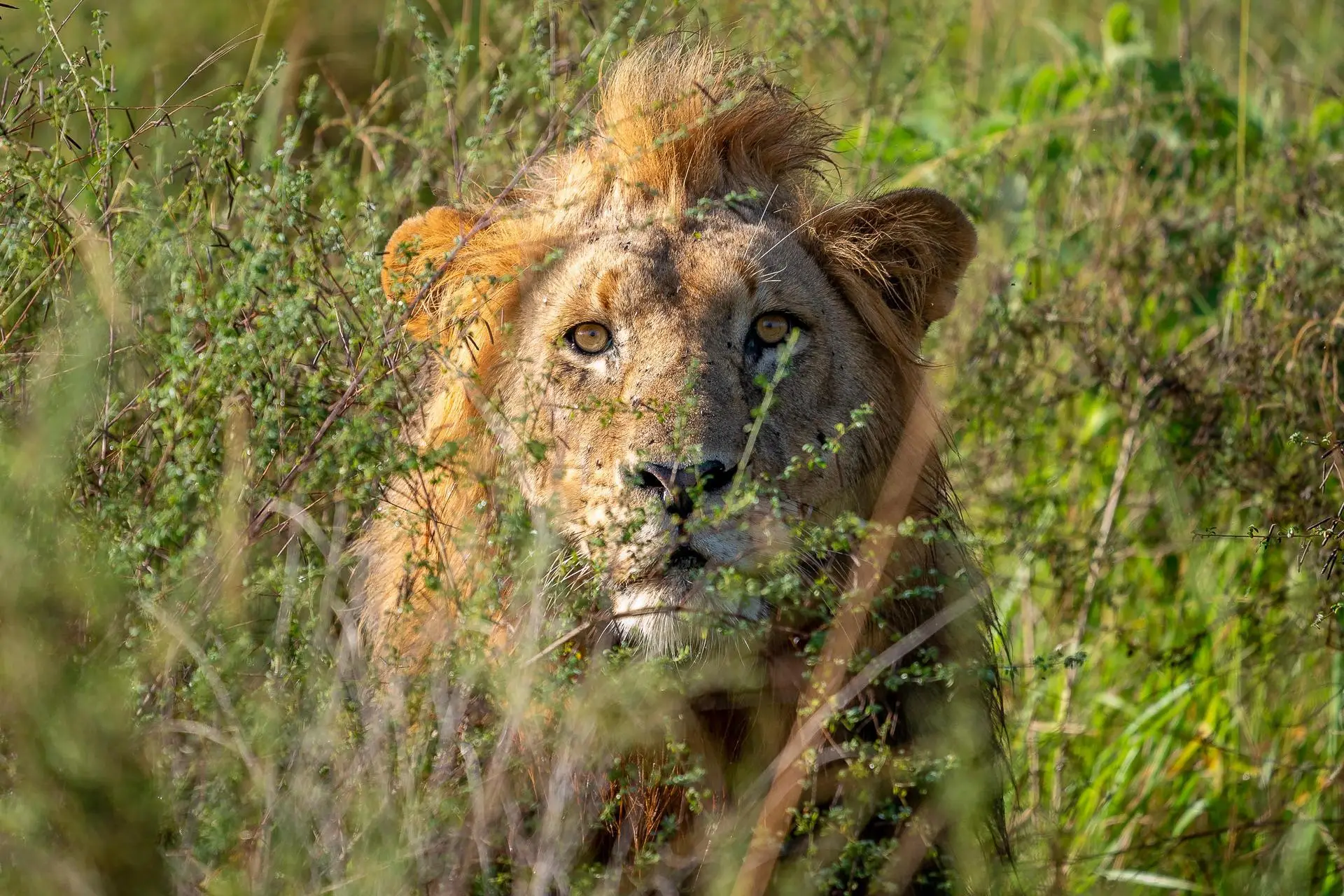
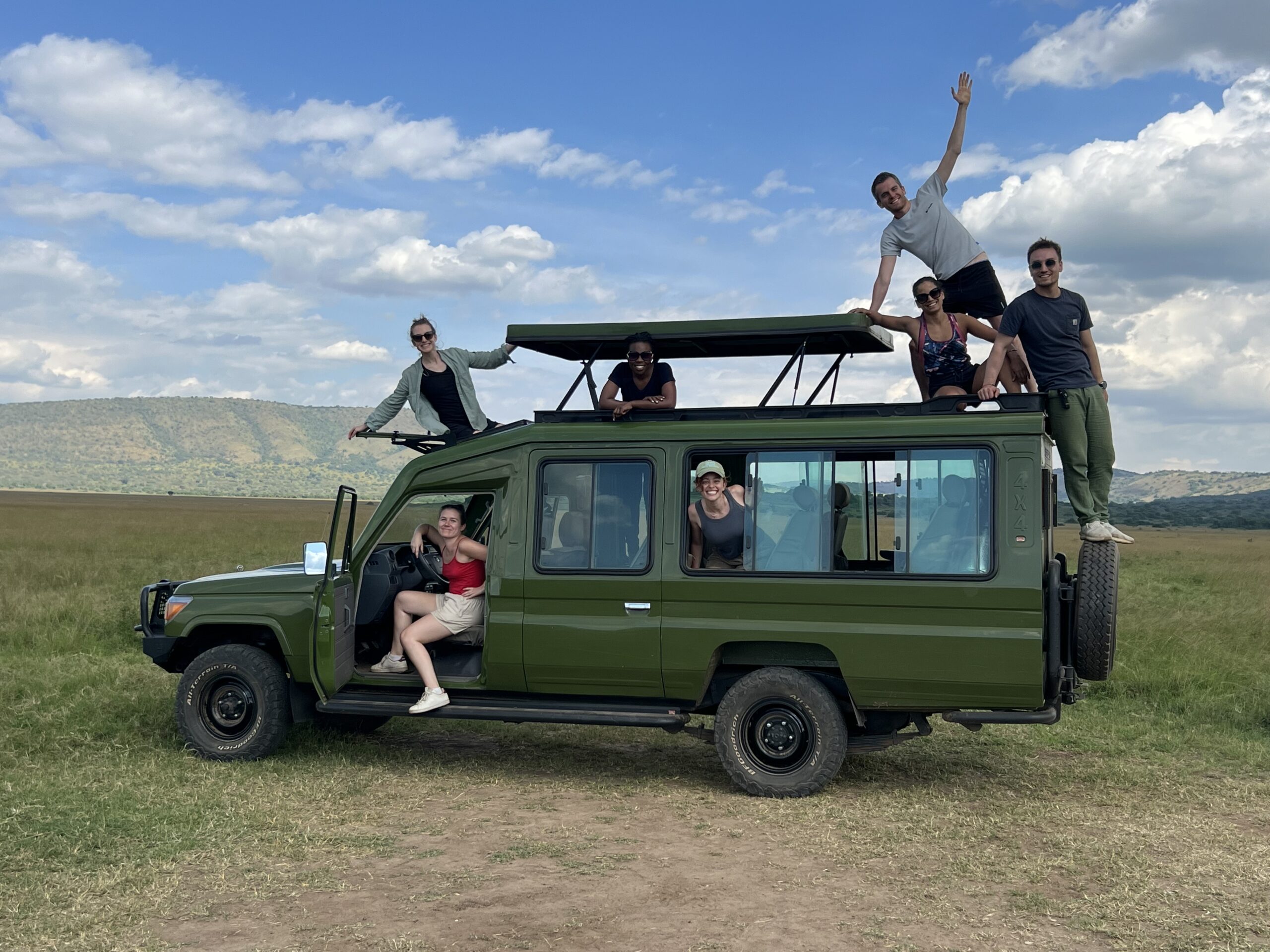
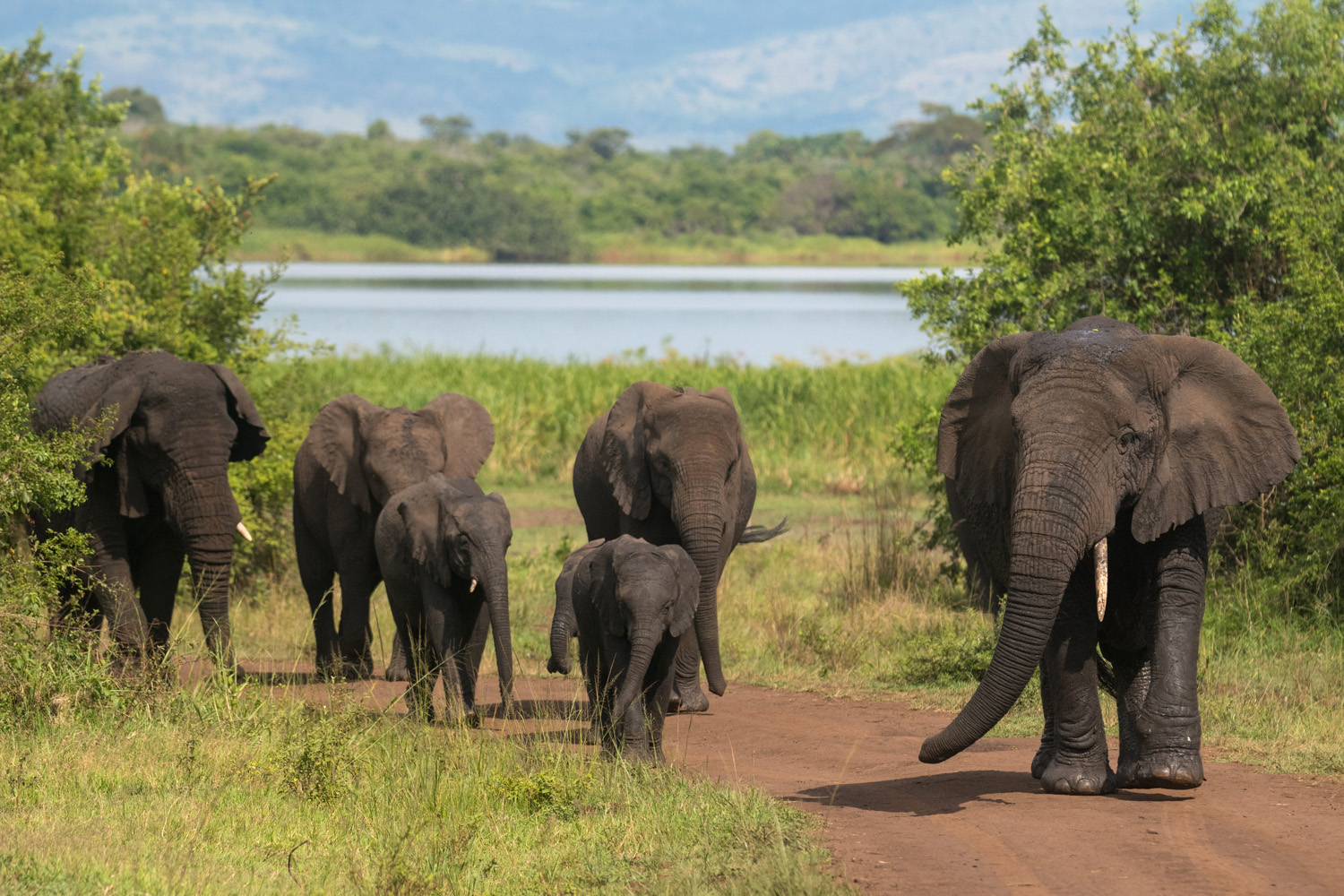
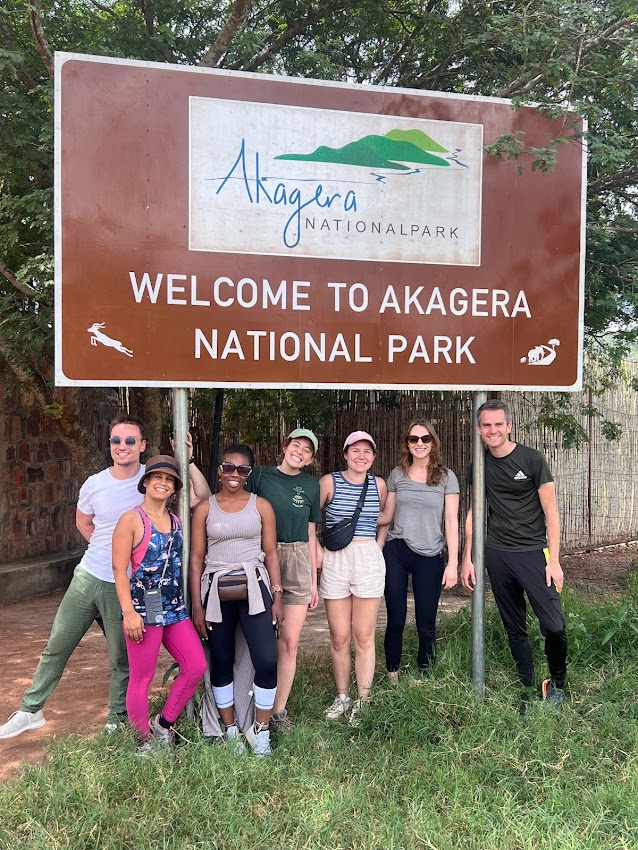
Facts About Akagera national park
Facts About Akagera national park : Akagera national park is located in north eastern part of Rwanda at the border with Tanzania and is the biggest protected area in Rwanda. The park was gazette in 1934 mainly to conserve and protect wildlife covers a total land area of 1,122 square kilometers but used to cover an area of 2500 square kilometers but was reduced to about 50% in 1997 when the land was reallocated as a farmland for the returning refugees after the 1994 Rwanda genocide. The refugees started cultivating the land, poaching wildlife and as a result in 2009 the government of Rwanda reduced the size of the park to 1122 square kilometers so as to create room for people and then protect wildlife. Akagera national park is therefore run and managed by Rwanda development board a tourism body together with African parks which is a conservation organization. The park is dominated by swamps, hills, acacia, woodland, grassland vegetation and small lakes and is named after Kagera River which flows along the eastern boundary of Rwanda and feed into Lake Ihema which is the second largest lake in Rwanda
Game drives
Akagera National Park is the only National Park in Rwanda where game drives are conducted. The rest of the parks are forest-dominated and frequently visited for primate encounters except Akagera. A guided game drive in Akagera NP takes in the different game trails in the Northern section of the park and offer clear view of wildlife species including the zebras, Maasai giraffes, African bush elephants, buffaloes, cape elands, rhinos, lions, leopards and 100s of bird species.
Boat cruise
If you enjoy viewing aquatic life, then you have every reason to be on a launch/boat cruise on your next Rwanda safari in Akagera National Park. The 2 to 3 hours launch trip gets you exposed to a variety of aquatic life including hippos, crocodiles and birds. Day boat cruise excursion in Akagera NP is done along Lake Ihema.
Birding
Bird watching in Akagera NP offers birder a great opportunity to identify diversity of birds. The available birds to be identified on birding tour in Akagera National Park include water thick-knee, long-toed thick-need, giant kingfish eagles, African open bill stork, Senegal lapwings, grey crowned cranes, long-crested eagles, cattle egrets, pied crow, fan-tailed widowbird, hadada ibis, black-headed & vieillot’s black weaver birds, Augur buzzard, carruther’s cisticolas, knob-billed ducks, fulvous whistling duck, white-faced whistling ducks, red-billed ducks,
Crested francolins, red-winged francolins, coqui francolins, blue quail, shelley’s francolins, ring-necked francolin, grasshopper buzzard, Caspian plover, Northern brown-throated weavers, Denham’s bustards, lesser moorhen, blue-shouldered robin chat, cabanis’s bunting, booted eagle, tabora cisticolas, western reef heron, to mention but a few.
Cultural tours
Next to Akagera NP are many cultural/communities to be visited for cultural interactions. The cultural tour in Akagera is a perfect opportunity for you to experience the actual rural Rwandan life and how rear cattle. It offers insight into the community-based tourism practices.
Hot air balloon tours
Hot air balloon excursions provide amazing opportunity for you to enjoy aerial view of Akagera National Park’s diverse wildlife species. This is done in the morning accompanied by bush breakfast and in the evening, but comes with champagne
Nyungwe National Park
Nyungwe Forest National Park is one of the primate-rich destinations in Africa, housing up to 13 distinct primate species. Its rich biodiversity and remarkable beauty is an amazing reason why it is one of the most treasured destinations by primate lovers on Rwanda safari.
Over 85 mammal species survive within Nyungwe Forest National Park and include 13 primate species, 400 colobus monkeys and other faunal species. The 13 species of primates include golden monkeys, chimpanzees, l’hoest monkeys, silver monkeys, red-tailed monkeys, grey-cheeked mangabeys, owl-faced monkeys, Angolan colobus monkeys, blue monkeys, Dent’s Mona monkeys, and olive baboons.
Nyungwe Forest National Park in Rwanda alone is host to more than 310 bird species. The park’s birds comprise of 27 Albertine rift endemic species, 121 forest bird species, 16 endemic species and more. The bird record in Nyungwe Forest NP include the white tailed blue flycatchers, purple-breasted sunbird, chestnut owlet, stripe breasted tit, great blue and Ruwenzori turacos, regal sunbird, Neumann’s short-tailed warblers, francolin mountain masked, white-bellied robin chat, white-headed wood hoopoe, red collared babblers, barred long-tailed cuckoos, archer’s robin chat and more.
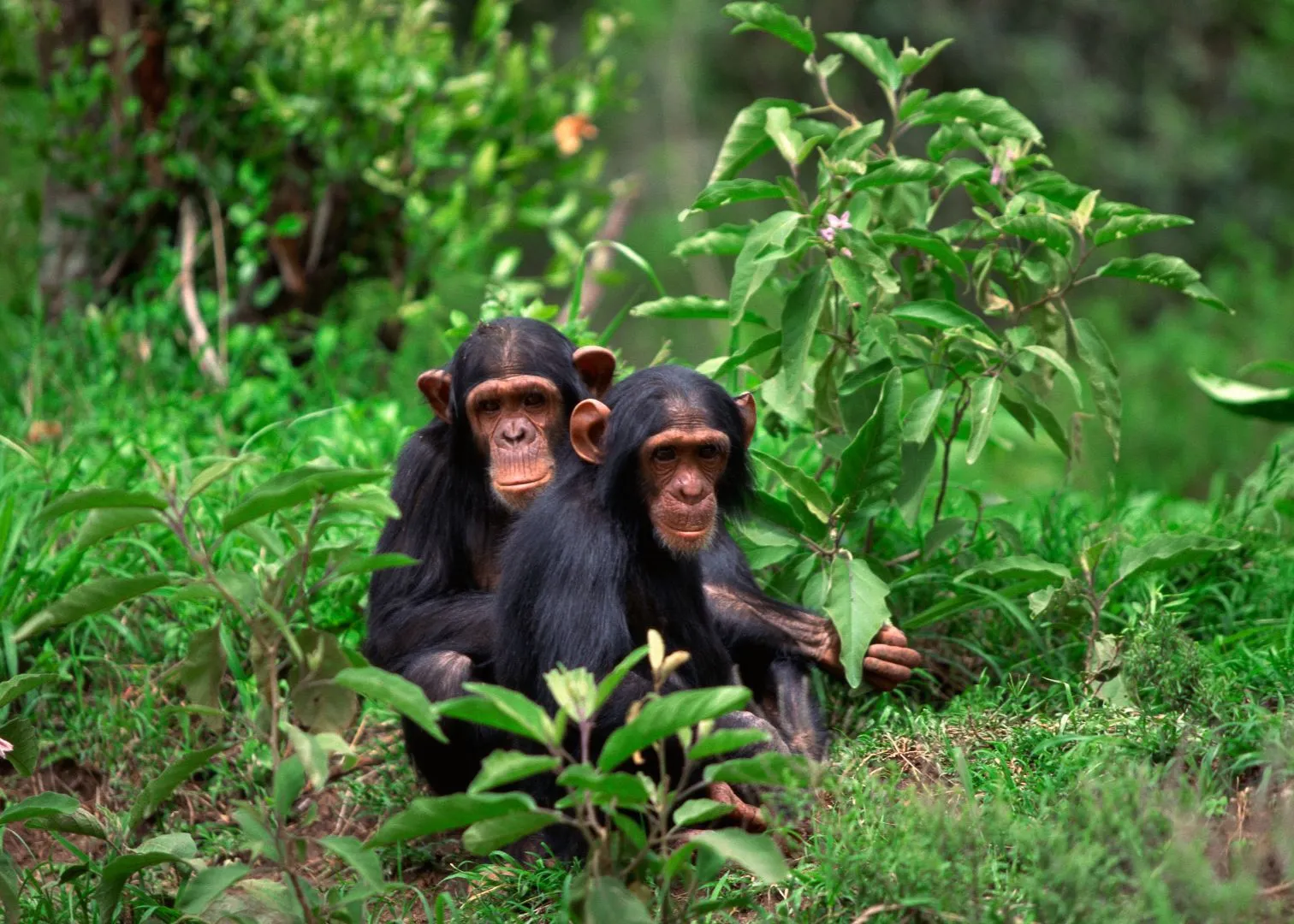
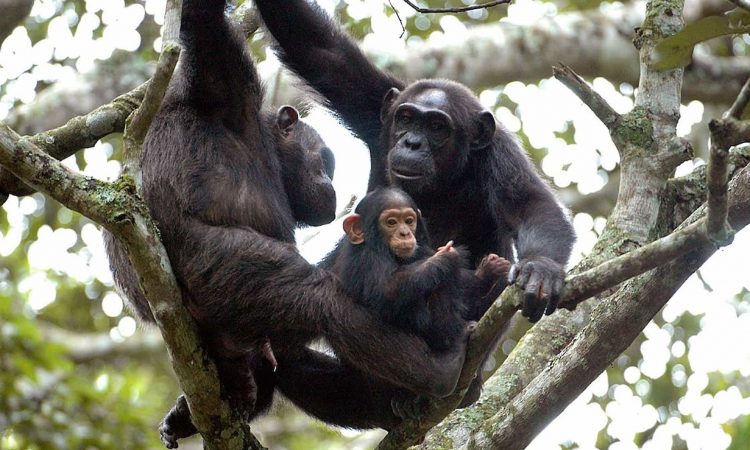
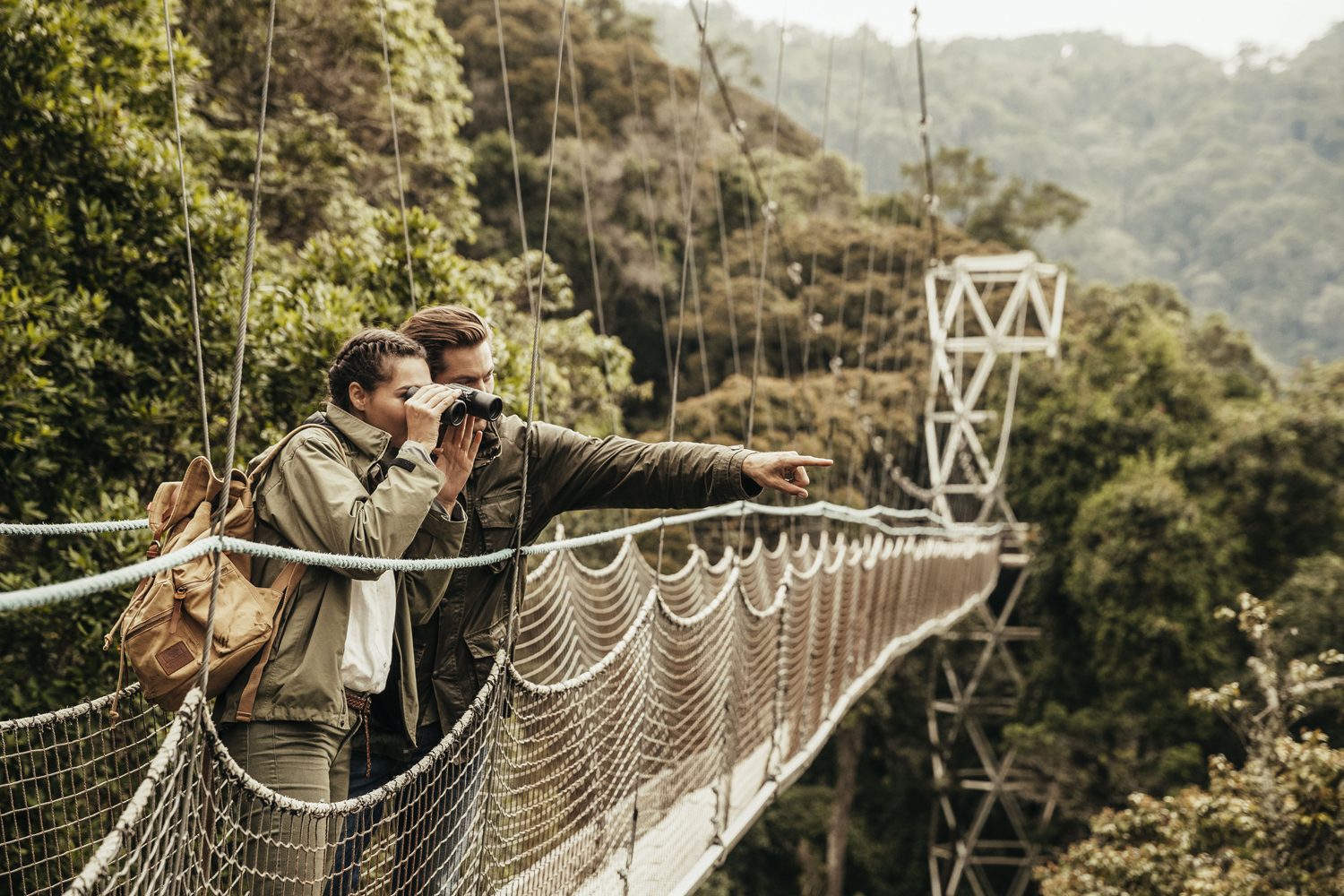
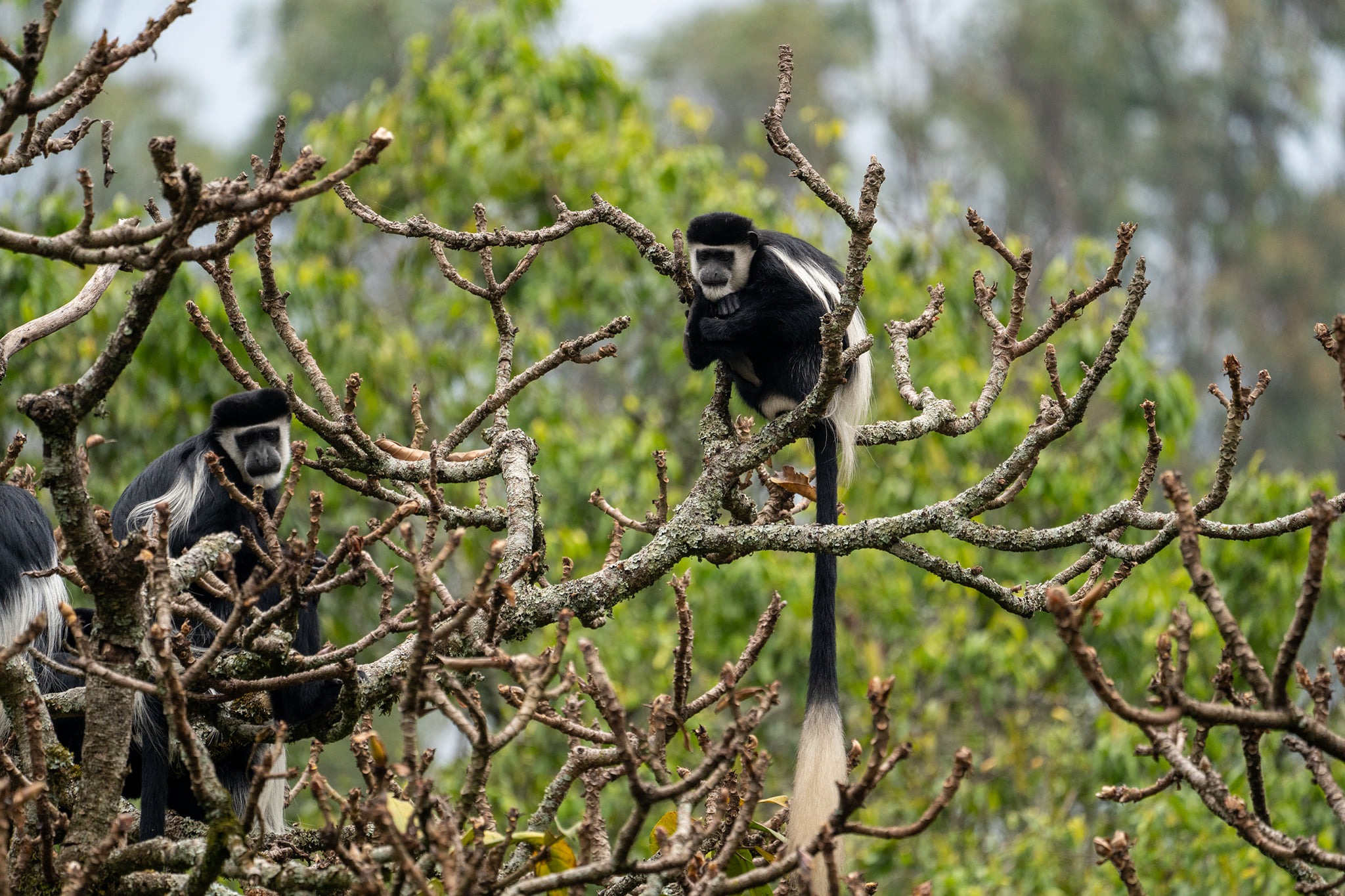

Facts About Nyungwe national park
Nyungwe Forest National Park (NFNP) is located in the Southern Province of Rwanda, featuring 2 main chimpanzee trekking sectors –Cyamudongo Forest and Uwinka. The park spans on the land area of 1019 sq.km along the Western Great Rift Valley, extending from Lake Albert to the Lake Tanganyika. Nyungwe lies nearby the Burundi border, South Lake Kivu and West of D.R. Congo.
Nyungwe Forest NP was founded as a Rwanda National Park in 2004 making it one of the recently created protected areas in Africa. Its creation was to offer shelter to its diverse wildlife comprising of over 85 mammal species, 2000 tree species, 1068 species of plants and 310 bird species.
At Nyungwe Forest National Park, it is possible to enjoy the spectacular views of the scenic Lake Kivu and part of the Virunga region. The park’s forest cover features well-kept network of incredible walking and hiking trails, waterfalls and several viewing points. The park has plenty of exciting experiences for nature lovers to enjoy ranging from chimpanzee tracking, hiking/nature walk, canopy walk, colobus monkey tracking to birding.
Nyungwe Forest National Park is one of the primate-rich destinations in Africa, housing up to 13 distinct primate species. Its rich biodiversity and remarkable beauty is an amazing reason why it is one of the most treasured destinations by primate lovers on Rwanda safari
Chimpanzee tracking
Chimpanzee trekking/tracking is the major reason why Nyungwe is a treasured primate destination in Rwanda. The park has 2 incredible chimpanzee communities to be visited each with habituated chimpanzees open to visitors to track. They include Cyamudongo and Uwinka Areas.
A total of 500 chimpanzees reside within the lush Nyungwe Forest and trekking can be done in the morning and afternoon. As you walk through the park, there is a chance to come across other primates like colobus monkeys, l’hoest monkeys, red-tailed monkeys, vervet monkeys, and others. Nyungwe chimp permits cost USD 100 per person per trek and your reliable tour operator can assist you to secure one and also plan the entire memorable trip.
Birdwatching
If you are an enthusiastic birder, Nyungwe Forest NP is one remarkable birding spot you shouldn’t miss visiting. The park holds variety of Albertine rift endemic species and other forest species. On a birding tour, some of the finest birds to identify in Nyungwe Forest National Park include Rwenzori turacos, Kivu ground thrush, white-tailed crested flycatchers, handsome francolins, red throated alethe, dwarf honey guide, and montane double collared sun bird, etc.
Colobus monkey tracking
More than 400 colobus monkeys thrive within the Nyungwe Forest National Park, and they can be explored on a guided colobus monkey tracking. Treks to explore park’s colobus monkeys begin early with briefing at the park offices and visitors are accompanied by park ranger guides.
Canopy walk
Nyungwe Forest National Park is the only park in East Africa that offers a guided canopy walking tours. This is done along the Igishigishigi trail, taking you through the suspended walkway 60 meters from the ground. As you walk through, you will be viewing the treetops with a chance of spotting diversity of primates
Nature walks/hiking
Nyungwe Forest NP is one park with a good network of hiking trails making it a preferred hiking/nature walking destination. The existing trails in the park include the 227km long Congo-Nile divide trail, Umoyove, Karamba, Igishigishigi, Irebero, Bigugu, Umugote, Uwinka, Imbaraga, Rukuzi, Ngabwe, Muzimu, Isumo and Kamiranzovu trails.
Cultural/community walk
Besides exploring the park’s primates, there is also a chance to visit the local communities to enjoy authentic Rwandan cultures and traditions. During the cultural tour, you can in position to learn more about importance of community-based tourism and it is playing a great role in wildlife conservation.
Gishwati-Mukura National Park
Gishwati-Mukura National Park is Rwanda’s newest national park, established in 2015. It plays a crucial role in biodiversity conservation and is home to a variety of primates, including chimpanzees, golden monkeys, and other wildlife. The park also contributes to Rwanda’s ecotourism efforts, offering visitors a chance to explore its pristine rainforest, nature trails, and community-based tourism initiatives.





Facts About GIshwati-mukura National park
Gishwati-Mukura Park is located in Northwestern Rwanda nearby Volcanoes National Park Ruhengeri. The park is set on the ridge which separates the Congo and Nile water catchment areas in Rutsiro and Ngororero districts. This is the smallest of all the four parks in Rwanda, spanning up to 34sq.km. Gishwati-Mukura NP was officially designated as a National Park in Rwanda in 2019 and its gates opened to tourists in 2019
Tourism Attractions in Gishwati-Mukura National Park
Most of Gishwati-Mukura National Park attractions have not been fully explored and include;
Primates
Gishwati-Mukura N/Park protects a combination of unique attractions in Gishwati & Mukura Forest Reserves. They include vervet monkeys, pottos, 20 chimpanzees, blue monkeys, galagos, l’hoest monkeys, golden monkeys, black and white colobus monkeys, olive baboons, silver monkeys and others. Besides primates, the park is home to wildlife such as chameleon, Southern tree hyrax, black fronted duikers and great lake bush vipers.
Floral species
Gishwati-Mukura NP is a forest dominated park and its floral species comprise of more than 60 tree species. These include hardwood and bamboo.
Bird species
Bird record of 232 bird species survive in the Gishwati-Mukura NP diverse habitats making it one of the special locations to enjoy birding tour in Rwanda. The bird check-list in this park include black faced apalis, dusky crimson wing, handsome francolin, red-throated alethe, mountain yellow warblers, Abyssinian ground thrush, martial eagle, white headed wood hoopoe, grauer’s swamp warblers, strange weaver birds, grey crowned cranes, purple breasted sunbird, regal sunbird, and others.
Primate trekking/chimpanzee tracking
The top experience that Gishwati-Mukura National Park offers the world is primate tracking or chimpanzee trekking. The park supports diversity of significant primates and you will have ample time to observe the daily behaviors of chimpanzees. Many other species of primates will be spotted including olive baboons, l’hoest monkeys, blue monkeys, golden monkeys, red-tailed monkeys, and others.
Birdwatching
If you are an enthusiastic birder, Nyungwe Forest NP is one remarkable birding spot you shouldn’t miss visiting. The park holds variety of Albertine rift endemic species and other forest species. On a birding tour, some of the finest birds to identify in Nyungwe Forest National Park include Rwenzori turacos, Kivu ground thrush, white-tailed crested flycatchers, handsome francolins, red throated alethe, dwarf honey guide, and montane double collared sun bird, etc.
Birding
Bird watching in Akagera NP offers birder a great opportunity to identify diversity of birds. The available birds to be identified on birding tour in Akagera National Park include water thick-knee, long-toed thick-need, giant kingfish eagles, African open bill stork, Senegal lapwings, grey crowned cranes, long-crested eagles, cattle egrets, pied crow, fan-tailed widowbird, hadada ibis, black-headed & vieillot’s black weaver birds, Augur buzzard, carruther’s cisticolas, knob-billed ducks, fulvous whistling duck, white-faced whistling ducks, red-billed ducks,
Crested francolins, red-winged francolins, coqui francolins, blue quail, shelley’s francolins, ring-necked francolin, grasshopper buzzard, Caspian plover, Northern brown-throated weavers, Denham’s bustards, lesser moorhen, blue-shouldered robin chat, cabanis’s bunting, booted eagle, tabora cisticolas, western reef heron, to mention but a few.
Colobus monkey tracking
More than 400 colobus monkeys thrive within the Nyungwe Forest National Park, and they can be explored on a guided colobus monkey tracking. Treks to explore park’s colobus monkeys begin early with briefing at the park offices and visitors are accompanied by park ranger guides.
Canopy walk
Nyungwe Forest National Park is the only park in East Africa that offers a guided canopy walking tours. This is done along the Igishigishigi trail, taking you through the suspended walkway 60 meters from the ground. As you walk through, you will be viewing the treetops with a chance of spotting diversity of primates
Nature walks/hiking
Nyungwe Forest NP is one park with a good network of hiking trails making it a preferred hiking/nature walking destination. The existing trails in the park include the 227km long Congo-Nile divide trail, Umoyove, Karamba, Igishigishigi, Irebero, Bigugu, Umugote, Uwinka, Imbaraga, Rukuzi, Ngabwe, Muzimu, Isumo and Kamiranzovu trails.
Cultural/community walk
Besides exploring the park’s primates, there is also a chance to visit the local communities to enjoy authentic Rwandan cultures and traditions. During the cultural tour, you can in position to learn more about importance of community-based tourism and it is playing a great role in wildlife conservation.
LAKE KIVU
Lake Kivu, also known as the Kivu Lake, is one of East Africa’s most remarkable natural wonders. Nestled amidst the lush green hills of the East African Rift Valley, this stunning lake straddles the border between Rwanda and the Democratic Republic of Congo. Covering an impressive 930 square miles (2,400 square kilometers) and plunging to depths of up to 1,575 feet (480 meters), Lake Kivu is not only Rwanda’s largest lake but also one of the deepest in the world. With its breathtaking backdrop of forested slopes, tropical vegetation, and idyllic islands, it’s a must-visit destination for nature lovers and adventure seekers alike.
The shores of Lake Kivu offer an incredible variety of experiences. In the north, you’ll find tranquil sandy beaches, while the lake’s largest islands, such as Idjwi, are located within the Democratic Republic of Congo. Surrounded by lush greenery—including eucalyptus trees and banana groves—the lake provides a serene and picturesque escape. Its crystal-clear blue waters are perfect for boat rides, water sports, or simply relaxing along the shore. Beyond its beauty, Lake Kivu offers visitors a glimpse into the geological history of the region, making it both a haven for relaxation and a fascinating natural landmark.
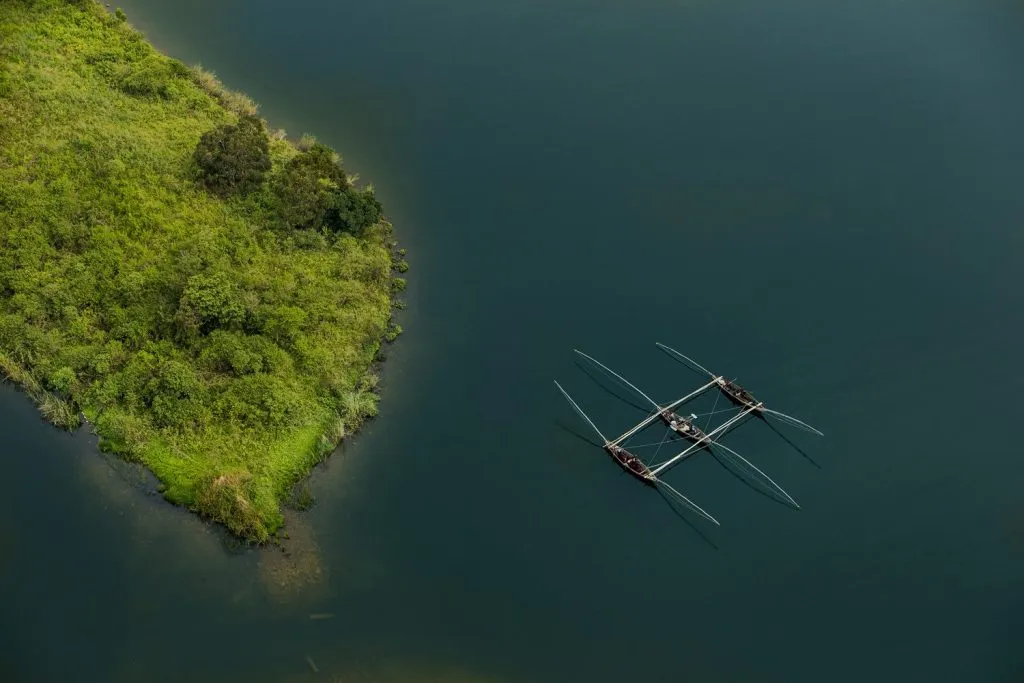

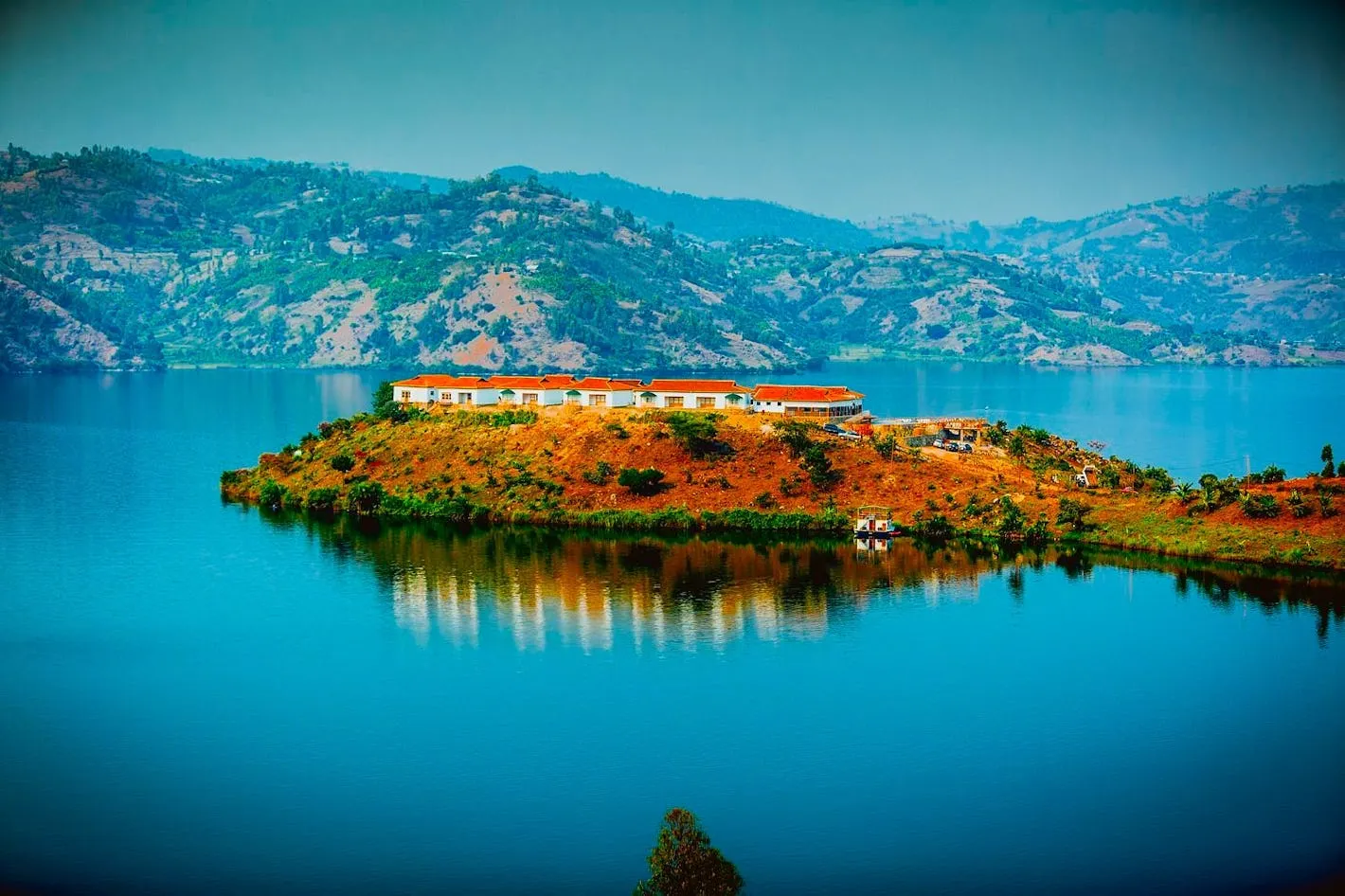
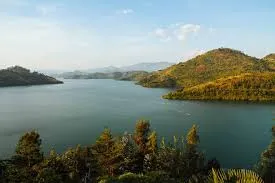
Geology and Unique Features of Lake Kivu
Lake Kivu is not just a scenic wonder—it’s a geological marvel. Situated within the volcanically active East African Rift Valley, the lake is surrounded by towering volcanoes, including Nyiragongo and Nyamuragira. These geological forces have shaped the lake and continue to influence its unique characteristics. One of the most fascinating aspects of Lake Kivu is its high concentration of methane and carbon dioxide, produced by volcanic activity and natural processes. The lake’s depths are estimated to contain a staggering 16 cubic miles (65 cubic kilometers) of methane, which is increasingly being harnessed for energy production—an innovative step toward regional development.
The lake’s stratified water layers, where cold, salty water traps dissolved gases deep below, create a unique ecosystem. While this feature carries potential risks, scientific monitoring and controlled methane extraction have minimized the hazards. Visitors to Lake Kivu not only experience its dramatic volcanic landscape but also gain insight into the intersection of nature, science, and sustainable development. This rare blend of geological uniqueness and natural beauty makes Lake Kivu an unparalleled travel destination.
The Beauty of Gisenyi
Located at the lake’s northern tip, Gisenyi—also known as Rubavu—exudes a tropical charm with its palm-lined beaches and relaxed ambiance. Framed by rolling hills covered in eucalyptus and pine forests, the town invites exploration and quiet retreats alike. The sunsets here are particularly captivating, painting the lake in hues of gold and orange, perfect for a romantic evening.
Gisenyi also offers a cultural journey into the region’s history and traditions. Colonial-era Belgian villas tell stories of the past, while bustling markets offer glimpses into daily life. Coffee enthusiasts can visit nearby plantations to learn about the cultivation and processing of Rwanda’s world-famous coffee—a must-do experience for any visitor.
Exploring the Tranquility of Kibuye
Kibuye, or Karongi, is a peaceful escape situated in the heart of Lake Kivu. Known for its lush vegetation and a scattering of small islands, it’s an ideal spot for relaxing boat tours. One standout destination is Napoleon Island, home to a spectacular colony of fruit bats. Their mesmerizing aerial displays make for an unforgettable wildlife encounter.
Kibuye also provides opportunities for cultural exploration. The serene Karongi Peace Park offers a quiet lakeside retreat, while the Bisesero Genocide Memorial provides a poignant insight into Rwanda’s history. A visit to nearby fishing villages allows travelers to experience the simplicity and charm of traditional lake life.
Cyangugu: A Gateway to Nature
At the southern end of Lake Kivu lies Cyangugu, also called Rusizi, a town renowned for its proximity to untouched wilderness. From here, visitors enjoy panoramic views of the lake and surrounding hills, which stretch toward the Nyungwe National Park. This dense rainforest is a haven for nature enthusiasts, offering activities like chimpanzee trekking and canopy walks. For a more relaxing experience, nearby Mashesha hot springs provide a soothing end to adventurous days.
Cyangugu’s vibrant Kamembe Market brims with local crafts and delicacies, while traditional music and dance performances showcase the area’s rich cultural heritage. The town’s ethnographic museum adds depth to any visit, telling the story of life around Lake Kivu through the ages.
Cultural Experiences and Local Encounters
- Adventurous Boating
- Culinary Delights
- Traditional Festivals and Cultural Events
KIGALI CITY
1. Historical and Cultural Attractions
- Kigali Genocide Memorial – A must-visit site that offers deep insights into Rwanda’s tragic history and resilience.
- Kandt House Museum – Showcasing Rwanda’s colonial history and natural history exhibits.
- Campaign Against Genocide Museum – Highlights the efforts of the Rwandan Patriotic Army in stopping the 1994 Genocide.
- Nyanza Genocide Memorial – Honoring the victims of the Genocide against the Tutsi.
2. Art and Handicrafts
- Inema Arts Center – A hub for contemporary Rwandan art, with exhibitions, live performances, and workshops.
- Kigali Cultural Village – A perfect place to experience traditional Rwandan culture, music, and dance.
- Caplaki Craft Village – Offers handmade souvenirs, including baskets, jewelry, and carvings.
3. Markets and Shopping
- Kimironko Market – The largest and busiest market in Kigali, where you can buy fresh produce, fabrics, and crafts.
- Kigali Heights & MTN Centre – Modern shopping malls with restaurants, cafés, and local boutiques.
4. Outdoor and Scenic Activities
- Mount Kigali Hike – A rewarding short hike with panoramic views of the city.
- Nyamirambo Walking Tour – Explore one of Kigali’s oldest and most vibrant neighborhoods, known for its local markets and cultural diversity.
- Rebero Hill Viewpoint – Enjoy breathtaking sunset views over the city.




GENOCIDE MEMORIAL SITE
Kigali genocide memorial site is one of four Rwanda genocide memorial sites on The list of world heritage site by UNESCO
The Kigali memorial site, the main one in the country, hosts the remains of 250,000 genocide victims found in the streets, houses, and mass graves in Kigali and surrounding areas.
In the Nyamata church in eastern Rwanda, south of Kigali, about 45,000 people who had sought refuge there were massacred in one day.
The building was transformed into a memorial representative of other churches in which the victims of the genocide died, according to UNESCO.
The Bisesero site on the other hand commemorates the resistance led with traditional weapons including spears, machetes and sticks by Tutsi against the genocide perpetrators.
“The historic inscription of the Bisesero, Gisozi, Murambi and Nyamata sites on the World Heritage List increases international visibility and also honors the memory of the victims they represent throughout the world.
NYANDUNGU ECO-PARK
The newly established Nyandungu Eco-Tourism park is located in the City of Kigali and was created as part of Rwanda’s efforts to restore and conserve ecosystems while promoting socio-economic development.
The restoration of the Nyandungu Wetland saw the planting of 17,000 trees made up of 55 indigenous species. The park features a medicinal garden, a Pope’s Garden, an information centre, a restaurant as well as more than 8km of walkways and bicycle lanes. The initiative has also supported livelihood diversification to enhance incomes for local communities by creating approximately 4,000 green jobs
UMUSAMBI VILLAGE
Umusambi Village is a beautifully restored wetland sanctuary for the endangered Grey Crowned Cranes to protect them from maltreatment and the illegal wildlife trade. Umusambi Village is also contributing to introducing injured cranes back to the wild and raising awareness about nature conservation.
Umusambi Village hosts more than 100 species of birds and is an eco-tourism destination in the City of Kigali. The cranes at Umusambi are living out the rest of their life in a safe and beautiful environment.
KIGALI GENOCIDE MEMORIAL SITE
Kigali genocide memorial site is one of four Rwanda genocide memorial sites on The list of world heritage site by UNESCO
The Kigali memorial site, the main one in the country, hosts the remains of 250,000 genocide victims found in the streets, houses, and mass graves in Kigali and surrounding areas.
In the Nyamata church in eastern Rwanda, south of Kigali, about 45,000 people who had sought refuge there were massacred in one day.
The building was transformed into a memorial representative of other churches in which the victims of the genocide died, according to UNESCO.
The Bisesero site on the other hand commemorates the resistance led with traditional weapons including spears, machetes and sticks by Tutsi against the genocide perpetrators.
“The historic inscription of the Bisesero, Gisozi, Murambi and Nyamata sites on the World Heritage List increases international visibility and also honors the memory of the victims they represent throughout the world.
- Volcanoes National Park
- Nyungwe Forest National Park
- Akagera National Park
- Gishwati Forest National Park

